Potrebujeme váš súhlas na využitie jednotlivých dát, aby sa vám okrem iného mohli ukazovať informácie týkajúce sa vašich záujmov. Súhlas udelíte kliknutím na tlačidlo „OK“.
ASTM E2232-10
Standard Guide for Selection and Use of Mathematical Methods for Calculating Absorbed Dose in Radiation Processing Applications
Automaticky preložený názov:
Štandardné Sprievodca pre výber a použitie matematických metód pre výpočet absorbovanej dávky v radiačnej vybavovania žiadostí o
NORMA vydaná dňa 1.7.2010
Informácie o norme:
Označenie normy: ASTM E2232-10
Poznámka: NEPLATNÁ
Dátum vydania normy: 1.7.2010
Kód tovaru: NS-44742
Počet strán: 19
Približná hmotnosť: 57 g (0.13 libier)
Krajina: Americká technická norma
Kategória: Technické normy ASTM
Kategórie - podobné normy:
Anotácia textu normy ASTM E2232-10 :
Keywords:
benchmarking, deterministic method, discrete ordinates, empirical method, mathematical models, modeling, modelling, Monte Carlo, point kernel, radiation processing, radiation transport, stochastic, validation, verification, Benchmark processing/testing, Discrete ordinates, Empirical knowledge, Mathematical models/modeling, Models/modeling--environmental, Monte Carlo method, Point kernel, Radiation exposure--nuclear materials/applications, Radiation processing, Stochastic modeling
Doplňujúce informácie
| Significance and Use | ||||||||||
|
Use as an Analytical Tool—Mathematical methods provide an analytical tool to be employed for many applications related to absorbed dose determinations in radiation processing. Mathematical calculations may not be used as a substitute for routine dosimetry in some applications (for example, medical device sterilization, food irradiation). Dose Calculation—Absorbed-dose calculations may be performed for a variety of photon/electron environments and irradiator geometries. Evaluate Process Effectiveness—Mathematical models may be used to evaluate the impact of changes in product composition, loading configuration, and irradiator design on dose distribution. Complement or Supplement to Dosimetry—Dose calculations may be used to establish a detailed understanding of dose distribution, providing a spatial resolution not obtainable through measurement. Calculations may be used to reduce the number of dosimeters required to characterize a procedure or process (for example, dose mapping). Alternative to Dosimetry—Dose calculations may be used when dosimetry is impractical (for example, granular materials, materials with complex geometries, material contained in a package where dosimetry is not practical or possible). Facility Design—Dose calculations are often used in the design of a new irradiator and can be used to help optimize dose distribution in an existing facility or radiation process. The use of modeling in irradiator design can be found in references (3-9). Validation—The validation of the model should be done through comparison with reliable and traceable dosimetric measurements. The purpose of validation is to demonstrate that the mathematical method makes reliable predictions of dose and other transport quantities. Validation compares predictions or theory to the results of an appropriate experiment. The degree of validation is commensurate with the application. Guidance is given in the documents referenced in Annex A2. Verification—Verification is the confirmation of the mathematical correctness of a computer implementation of a mathematical method. This can be done, for example, by comparing numerical results with known analytic solutions or with other computer codes that have been previously verified. Verification should be done to ensure that the simulation is appropriate for the intended application. Refer to 3.1.23.1. Note 2—Certain applications of the mathematical model deal with Operational Qualification (OQ), Performance Qualification (PQ) and process control in radiation processing such as the sterilization of healthcare products. The application and use of the mathematical model in these applications may have to meet regulatory requirements. Refer to Section 6 for prerequisites for application of a mathematical method and Section 8 for requirements before routine use of the mathematical method. Uncertainty—An absorbed dose prediction should be accompanied by an estimate of overall uncertainty, as it is with absorbed-dose determination (refer to ISO/ASTM 51707 and NIST Technical Note 1297). In many cases, absorbed-dose measurement helps to establish the uncertainty in the dose calculation. This guide should not be used as the only reference in the selection and use of mathematical models. The user is encouraged to contact individuals who are experienced in mathematical modelling and to read the relevant publications in order to select the best tool for their application. Radiation processing is an evolving field and the references cited in the annotated examples of Annex A6 are representative of the various published applications. Where a method is validated with dosimetry, it becomes a benchmark for that particular application. |
||||||||||
| 1. Scope | ||||||||||
|
1.1 This guide describes different mathematical methods that may be used to calculate absorbed dose and criteria for their selection. Absorbed-dose calculations can determine the effectiveness of the radiation process, estimate the absorbed-dose distribution in product, or supplement or complement, or both, the measurement of absorbed dose. 1.2 Radiation processing is an evolving field and annotated examples are provided in Annex A6 to illustrate the applications where mathematical methods have been successfully applied. While not limited by the applications cited in these examples, applications specific to neutron transport, radiation therapy and shielding design are not addressed in this document. 1.3 This guide covers the calculation of radiation transport of electrons and photons with energies up to 25 MeV. 1.4 The mathematical methods described include Monte Carlo, point kernel, discrete ordinate, semi-empirical and empirical methods. 1.5 General purpose software packages are available for the calculation of the transport of charged and/or uncharged particles and photons from various types of sources of ionizing radiation. This standard is limited to the use of these software packages or other mathematical methods for the determination of spatial dose distributions for photons emitted following the decay of 137Cs or 60Co, for energetic electrons from particle accelerators, or for X-rays generated by electron accelerators. 1.6 This guide assists the user in determining if mathematical methods are a useful tool. This guide may assist the user in selecting an appropriate method for calculating absorbed dose. The user must determine whether any of these mathematical methods are appropriate for the solution to their specific application and what, if any, software to apply. Note 1—The user is urged to apply these predictive techniques while being aware of the need for experience and also the inherent limitations of both the method and the available software. Information pertaining to availability and updates to codes for modeling radiation transport, courses, workshops and meetings can be found in Annex A1. For a basic understanding of radiation physics and a brief overview of method selection, refer to Annex A3. 1.7 This standard does not purport to address all of the safety concerns, if any, associated with its use. It is the responsibility of the user of this standard to establish appropriate safety and health practices and determine the applicability of regulatory requirements prior to use. |
||||||||||
| 2. Referenced Documents | ||||||||||
|
Podobné normy:
Historická
1.4.2013
Historická
1.5.2012
Historická
1.4.2014
Historická
15.11.2013
Historická
1.3.2013
Historická
1.12.2013


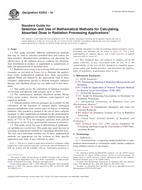
 ASTM E2234-09(2013)..
ASTM E2234-09(2013)..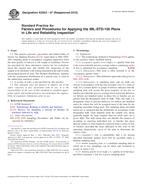 ASTM E2555-07(2012)..
ASTM E2555-07(2012)..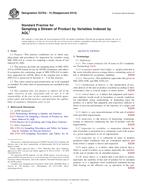 ASTM E2762-10(2014)..
ASTM E2762-10(2014)..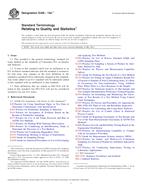 ASTM E456-13ae1
ASTM E456-13ae1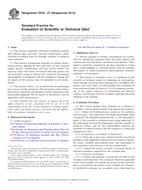 ASTM E678-07(2013)..
ASTM E678-07(2013)..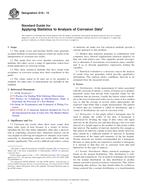 ASTM G16-13
ASTM G16-13
 Cookies
Cookies
